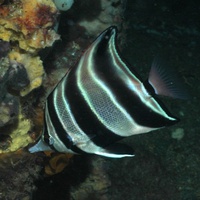Changes in South Australia's marine ecosystems
Laura Purcell.
Ocean ecosystems are changing and some fish are on the move along the South Australian coast.
The marine environment off the South Australian coast is diverse with kelp forests, deep water sponge gardens, rocky coasts, offshore islands, and cliff and mangrove systems. These habitats support a rich ecosystem of thousands of invertebrates such as squid and rock lobsters, over a thousand varieties of algae, hundreds of different fish species, 33 mammal species, 16 breeding seabird species and 12 kinds of seagrass. Most of the red algae, fish species and seagrass in the South Australian marine waters are found nowhere else in the world (Baker, 2004; Edyvane, 1999).
Ecologically, South Australia’s marine environment shares many similar fishery resources and habitats with the neighbouring states of Tasmania, Victoria and New South Wales. As a result of climate change, water temperatures off the south-west and south-east of Australia are warming faster than other regions. In the last 60 years the East Australian Current (EAC) is getting stronger pushing warmer saltier water further south and the Leeuwin Current is slowly getting weaker, which will have implications on the biodiversity of species in South Australia. These changes are leading to South Australia’s marine ecosystem, suited to cool-temperate waters, to become less productive as they change their habitat or even become extinct.
South Australian marine life are ‘feeling the heat’ of changes in the ocean including: the Australian Sea Lion Neophoca cinerea, Leafy Sea Dragon Phycodurus eques, Southern Rock Lobster Janus edwardsii and varieties of kelp, such as the common kelp Ecklonia radiata, crazyweed Phyllospora comosa and giant kelp Macocystis pyrifera.
.jpg)
Australian Sea Lions, Neophoca cinerea, are feeling the heat in SA. (Photo: Alistair Hobday).
Most of the Australian Sea Lion population is based in South Australia. They feed on squid, fish, rock lobster, seabirds and shark. As the ocean warms, it is expected the Australian Sea Lion’s food supply will reduce - such as smaller adult sizes and less migration of southern rock lobster - and the chance of disease spreading will increase.
Whilst the Australian Sea Lion prefers a particular habitat to breed and are not likely to migrate, certain varieties of kelp are moving south towards cooler waters, and are even disappearing from urban areas like Adelaide. Kelp forests are rich and productive ecosystems, so their migration is leaving behind some marine creatures without a home and food supply. When the kelp moves out, turf-forming algae moves in, preventing the regrowth of kelp forests.
Leafy sea dragons (Phycodurus eques), the emblem of South Australia, are very susceptible to environmental disturbances. As their habitat diminishes and the ocean warms they are more likely to suffer in storm events.
.jpg)
The leafy sea dragon Phycodurus eques (Rapid Bay SA) is vulnerable to warming seas (Photo:Graham Edgar).
Read more about South Australia’s changing ecosystem, in response to climate change:
Marine Adaptation Network’s Information Sheet #4. “Climate Change & the Marine Environment: South Australia.” http://arnmbr.org/content/images/uploads/Information_Sheet_4.pdf
Marine Climate Change in Australia: Impacts & Adaptation Responses. 2009 Report Card. http://arnmbr.org/content/images/uploads/Report_card_web.pdf
Trend. Marine Ecosystems: http://www.trendsa.org.au/marine
Marine Climate Change in Australia: Impacts and Adaptation Responses. 2012 Report Card http://www.oceanclimatechange.org.au/content/images/uploads/Marine_Report_Card_Australia_2012.pdf
About the Author
Laura Purcell is Communications and Publicity Officer for the Marine Adaptation Network (Adaptation Research Network for marine Biodiversity & Resources) www.nccarf.edu.au/marine












